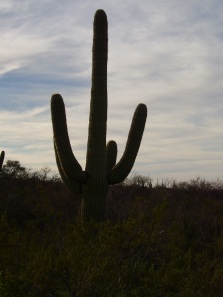
When you think of the desert you might envision a hot sun beating down with scorching intensity on windblown sand dunes, a hostile terrain devoid of water. While some of that might be true, for the most part Arizona’s Sonoran Desert reveals an immensely different view. If you want a true feel for life in the desert, here are 6 places you won’t want to miss.
Marvel at the Stately Saguaro
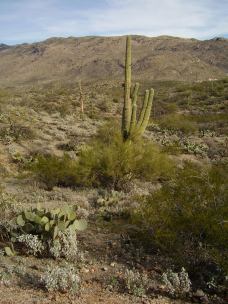
Start your journey in Tucson’s Saguaro National Park, a massive saguaro preserve that splits into two districts 30 miles apart. The Rincon Mountain District on the east side of Tucson contains an older part of saguaro cactus forest at the foot of the Rincon Mountains. The Tucson Mountain District on the west side of Tucson is biologically younger and smaller than its counterpart on the east side.
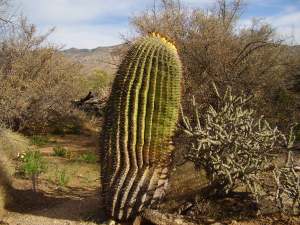
Because the Rincon Mountain District has a wide range of elevations you’ll witness more diverse plant life like the desert scrub, the desert grassland, and the mixed conifer. One of the best ways to experience the panoramic views of the Rincon Mountains and the tremendous forest of saguaro cactus is to wander off on one of their hiking, biking or auto trails. The Cactus Garden Trail is an easy trail to navigate and here you’ll get a good sense of the Sonoran Desert surroundings. The eight-mile Cactus Forest Loop Drive gives you a chance to get out of the car and stroll among the spectacular saguaros.
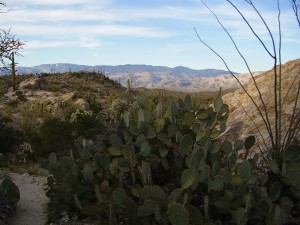
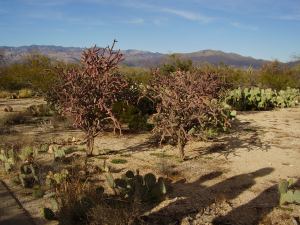
The Tucson Mountain District has equally large and wide-ranging saguaros, including over 50 cactus species. Here you’ll have an opportunity to enjoy the most abundant species, the exotic forms of cholla cacti such as the teddy-bear cholla and the buckhorn cholla.
Learn How Plants and Animals Adapt to the Desert
Dedicated to the conservation of the Sonoran Desert, the Arizona-Sonora Desert Museum, 14 miles west of Tucson, treats you to wildlife action and intriguing vegetation. The museum includes the Earth Sciences Center, which features a simulated underground limestone cave and regional minerals, complete with stalagmites, stalactites and pools.
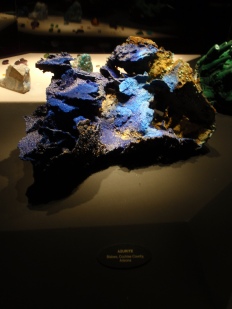
If you want to indulge in a true cave experience, a side tunnel (designed with kids in mind), takes you 75 feet through low ceilings, tight passageways and jagged paths. Once you’re back on even footing, you’ll discover a large screen filled with erupting volcanoes describing the birth of our world. Next up is the one of a kind regional mineral and gemstone collection. Examine gold from the Santa Rita Mountains in Arizona, or the pearly luster of Smithsonite from Arizona’s Glove Mine. You’ll also get an opportunity to see a velvet blue azurite and specs of gold.

As you wander through the reptiles and invertebrates section of the desert museum, don’t miss the Rosy Boa, a small version of the large boa constrictor. Rosy Boa’s feed on mice and birds and live in low rocky areas near streams.
As you follow paths around the desert area, be on the lookout for bobcats, hiding out under cliff ledges away from the sun during the day, to spectacular jaguars and spotted ocelots and margays. Desert trails take you past colorful cacti, plants and trees, including the furry teddy-bear cholla cactus, organ pipe cactus, the ocotillo, the elephant tree and the mesquite, all flourishing under the hot sun.
Wrap up your visit with a hike around the Desert Loop Trail. Here you might find the pig-like javelinas munching on prickly pear cacti or coyotes wandering among the desert’s native vegetation. There’s plenty to see and do as you enjoy over 1200 species of plants and 300 species of animals living in their natural habitats, as well as the superb collection of regional minerals and gemstones.
Head Underground
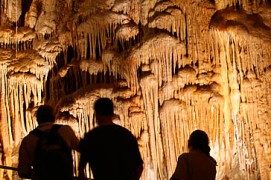
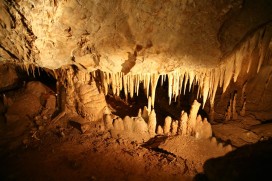 Examine a stunning living limestone cave filled with minerals not found in any other cave at Kartchner Caverns State Park in Benson, fifty miles southeast of Tucson. Discovered in 1978 serenely nestled beneath the Sonoran Desert, experts rate the Kartchner Caverns as one of the world’s top 10 caverns because of its multi-colored stalactites, stalagmites and flowstone mineral formations.
Examine a stunning living limestone cave filled with minerals not found in any other cave at Kartchner Caverns State Park in Benson, fifty miles southeast of Tucson. Discovered in 1978 serenely nestled beneath the Sonoran Desert, experts rate the Kartchner Caverns as one of the world’s top 10 caverns because of its multi-colored stalactites, stalagmites and flowstone mineral formations.
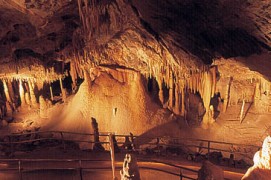
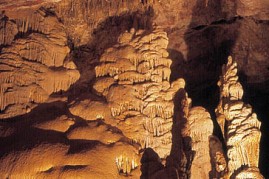 In the Throne Room you’ll encounter Kubla Khan, a massive 58 foot column formed when a stalagmite and stalacitite grew into one another. Nearby thin and hollow stalactites form one of the longest soda straw stalactites in the world measuring 21 feet and 2 inches. Don’t miss the flowstone formation, which are layered calcite deposits resembling a frozen waterfall.
In the Throne Room you’ll encounter Kubla Khan, a massive 58 foot column formed when a stalagmite and stalacitite grew into one another. Nearby thin and hollow stalactites form one of the longest soda straw stalactites in the world measuring 21 feet and 2 inches. Don’t miss the flowstone formation, which are layered calcite deposits resembling a frozen waterfall.
You’ll also learn how approximately 1,500 bats live in the Kartchner Caverns for part of the year. No need to panic. The Big Room, the largest room in the caverns, is closed from mid-April through mid-October when the room is occupied by nursing bats.
Watch Out for the Shoot Out
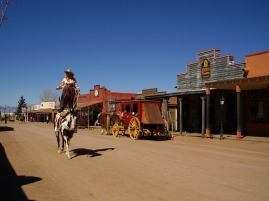
Continue south on AZ-80 and enjoy gunfight shows and stagecoach rides, the Bird Cage Theatre, the O.K Corral, and Boot Hill Cemetery in Tombstone. “The Town Too Tough to Die” is located 70 miles southeast of Tucson. Step back into the rough and tumble days of the Wild West where Doc Holliday and Wyatt Earp shot it out with the Clanton and McLaury Gang at the Gunfight at OK Corral.
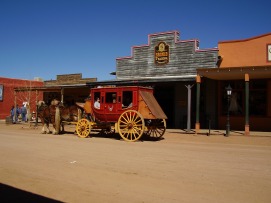
In the 1880’s the booming mining town of Tombstone prospered. But the town’s saloons and gambling halls that lined the streets caused poker game shootouts and drunken-provoked gunfights. The Bird Cage Theatre lived up to this rowdy reputation as an all in one theater, saloon, gambling hall and brothel.
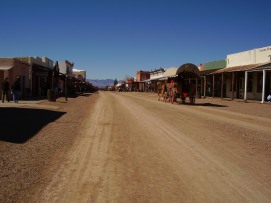
A visit to Boot Hill Cemetery (or Graveyard) confirms the lawlessness and violence that ruled historic Tombstone. Between 1878 and 1884, this was the final resting place for approximately 300 gunfighters and others who died abruptly or violently. As you walk through this sad and eerie cemetery one strangely humorous headstone stands out. Proving that even the rough and tumble gunslingers of the west had a sense of humor, Lester Moore’s epitaph reads:
Here Lies
Lester Moore
Four Slugs
From A 44
No Les
No More
Turn-of-the-Century Charm
About 20 miles further south on AZ-80 you’ll discover a revived Bisbee. In the early 1900’s, Bisbee’s population soared as fortune hunters rushed to one of the richest mineral sites in the world. The town boasted over 47 saloons (famously know as Brewery Gulch), gambling establishments and their own stock exchange. When depleted ore reserves closed the mines in 1975, it looked like Bisbee might come to a grinding halt. But the town continued to prosper in other ways.
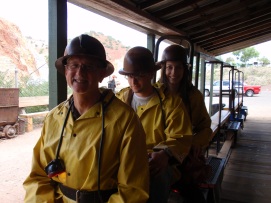
In 1976, Bisbee’s mayor promoted mine tours as a way to keep the miners employed. My family and I signed up for the Queen Mine Tours and found out what it was like to work in a mine. We started our mining excursion by donning yellow slickers, hard hats and wrapping a miner’s headlamp around our shoulders. Mining trains carried us 1,500 feet down into the mines where the temperature dipped to 47 degrees. A retired miner led the tour and described working conditions and the dangers miners encountered underground.

When the mines closed, the Bisbee housing market collapsed and real estate was at an all time low. Fortunately cheap housing and an alluring climate attracted artists and visionaries and the mining town took on a new look. Today, art galleries, antique shops, gourmet restaurants, coffee houses, book stores and specialty shops flourish on Bisbee’s Main Street.
Renovations to Bisbee’s European and Victorian-styled houses and
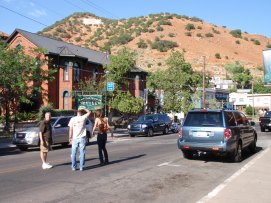
buildings in the late 1970’s also enhanced property values. One renovation in particular, The Copper Queen Hotel, was a key reason Bisbee retained its authentic old town charm. And if you visit there today, you may get an opportunity to experience paranormal activity. During your visit, listen for phantom footsteps of a young giggling boy running through the hallways. Polk around the “Julia Lowell Room” and you might hear the former “lady of the evening” whisper in your ear.
Bisbee is about 90 miles south of Tuscan.
High Quality, Good Value Wines in the Arizona Desert
Most visitors don’t expect to indulge in a wine tasting adventure in the desert. But if you can break away from Arizona’s fiestas and festivals, mining and mineral museums, and gunfight shows and ghost towns, head to the Sonoita/Elgin Region, about 45 minutes south of Tuscan, for a sampling of delightfully complex wines you’re sure to enjoy.
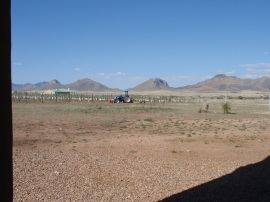
The Sonoita/Elgin region is one of three major wine growing areas in the state. All three areas are located high in the desert, somewhere between 4200 and 5200 feet. The high desert produces an ideal climate for growing grapes, hot daytime temperatures that cool off at night. The rainy season in July and August provides some additional water for the vineyards.
Sonoita Vineyards, a 25 acre vineyard located on a hillside, is the state’s oldest and largest winery. Planting the vines on the hillside protects the vines from severe winds and frost. In addition to the late summer rainy season that provides needed water, Sonoita Vineyards is on drip irrigation (water pumped from a well).
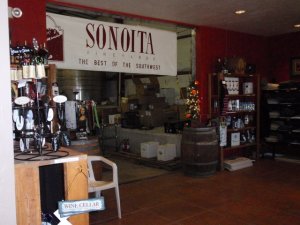
We tasted a number of featured wines in Sonoita Vineyards’ spacious 5000 square foot wine tasting room ranging from the light and fruity Sonora Rossa to the bold and complex Arizona Fume. Sonoita Vineyards’ wine tasting connoisseur described the subtle delicacies and pairings of each of the winery’s premium wines. For example, the sweet and delicate Sonora Blanc blends well with cheesecake or a fruit and cheese plate.
Our wine tour continued at the Kief-Joshua Vineyards’ elegant Italian Gothic styled wine tasting room. Here we sipped exquisite wines as their wine specialists paired each wine with mouthwatering meals and desserts. They suggested their 2009 Chenin Blanc if you love grilled fish or like to finish off a meal with crème brulee.
Kartchner Caverns State Park photos courtesy of Arizona State Parks
All other photos by Maureen C. Bruschi
Further Information:
By Air: Tucson International Airport is within driving distance of all sights.
Where to Stay: Tucson Hotel Reviews and Compare Prices …
Saguaro National Park – www.nps.gov/sagu
Arizona-Sonora Desert Museum – www.desertmuseum.org
Kartchner Caverns State Park – www.azstateparks.com
Tombstone – www.cityoftombstone.com; www.tombstonechamber.com
Bisbee – www.discoverbisbee.com; www.cityofbisbee.com
Queen Mine Tours: www.queenminetour.com
Where to Stay in Bisbee: Copper Queen Hotel, 11 Howell Avenue (www.copperqueen.com)
Where to Eat in Bisbee: Café Roka, 35 Main Street (www.caferoka.com); The Bisbee Grill, 2 Copper Queen Plaza; The Bisbee Coffee Company, 2 Copper Queen Plaza
Sonoita/Elgin Region – www.sonoitavineyards.com; www.kj-vineyards.com
Where to Stay: www.patagoniaaz.com
Where to Eat: Viaggio Italiano Ristorante, 3266 Highway 82S, Sonoita, AZ 85637 (520) 455-5282
©Maureen C. Bruschi
